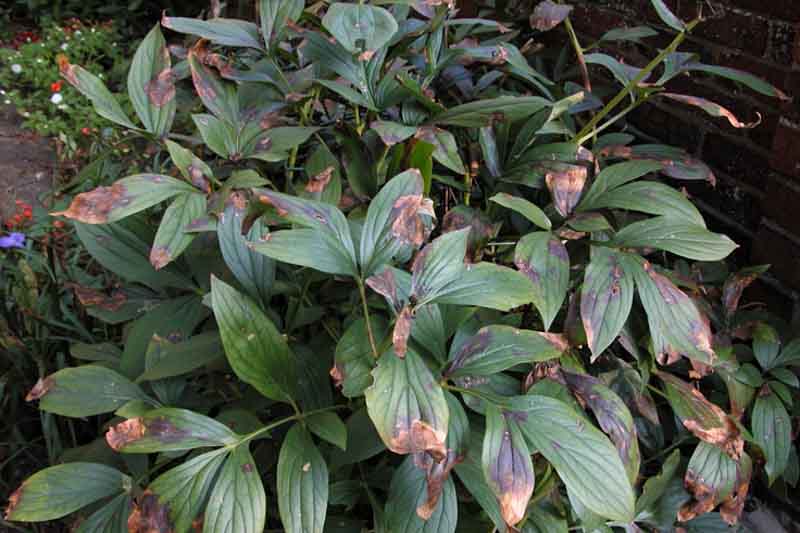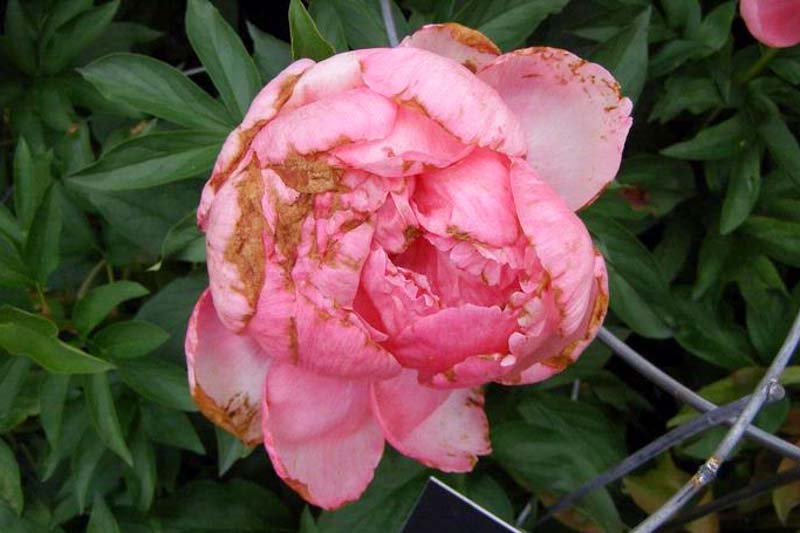How to Identify, Prevent, and Treat Botrytis Blight of Peony
Botrytis Blight of Peony (Botrytis paeoniae), also known as gray mold, is a fungal pathogen affecting peonies. Botrytis paeoniae is part of the Botrytis genus, which includes several fungi known for causing ‘gray mold’ diseases on a variety of plants. This particular species, however, has a specific affinity for peonies.
Botrytis paeoniae is prevalent in regions with temperate climates, particularly where peonies are commonly grown. This includes parts of North America, Europe, and Asia. The fungus thrives in areas with cool, damp spring weather.

Bud Rot: One of the first signs is the rotting of flower buds, which turn brown and fail to open. The buds may appear water-soaked and can be covered with a gray mold.
Stem Lesions: Look for water-soaked, discolored lesions on the stems, particularly near the base of the plant. These lesions can enlarge and girdle the stem, causing the stem to break or the foliage above to wilt.
Leaf Blotch and Mold: Infected leaves develop brown or black blotches, often with a concentric ring pattern. In humid conditions, you may also see a fuzzy gray mold on the leaves, stems, or buds.
Flower Damage: Flowers that do manage to open may become discolored or spotted and can also develop gray mold, especially in damp weather.
Overall Plant Health: Affected plants often exhibit a general decline in health, with wilting and dying foliage. In severe cases, the entire plant may collapse.
If you suspect your peonies are suffering from Botrytis blight, it’s essential to act quickly to prevent the spread of the fungus to healthy parts of the plant and to neighboring plants. Regular inspection, especially during cool, damp spring weather, is key to early detection and effective management of this disease.

Botrytis paeoniae thrives in cool, moist conditions. Extended periods of rain, high humidity, and temperatures between 59-68°F (15-20°C) create ideal conditions for its growth. The fungus overwinters on plant debris and in the soil, re-emerging in spring to infect new growth.
Proper Plant Spacing: Ensure adequate spacing between your peonies and other plants. Good air circulation is crucial for keeping the foliage dry and preventing the growth of fungi.
Avoid Overhead Watering: Water at the base of the plant to keep the foliage dry. Wet leaves can encourage the growth of Botrytis. Early morning watering is preferable so that any water on the foliage can dry during the day.
Prune and Clean: Regularly prune your peonies to remove any dead or diseased foliage, especially during the fall cleanup. This helps reduce the amount of fungal spores that can overwinter.
Mulch Appropriately: Use mulch to prevent soil-borne spores from splashing onto plants, but keep the mulch a few inches away from the plant stems to avoid excess moisture around the base.
Fungicides: In areas where Botrytis is a recurring problem, consider applying a preventative fungicide in the spring as the new shoots emerge. Always follow the manufacturer’s instructions for application.
Healthy Soil: Maintain healthy soil with adequate drainage. Overly wet soil can contribute to the development of fungal diseases.
Remove Infected Blooms: As soon as you notice any infected flowers or buds, remove them immediately to prevent the spread of the fungus to healthy parts of the plant.
Monitor Weather Conditions: Botrytis thrives in cool, damp weather. Be especially vigilant during prolonged periods of rain or high humidity in the spring.
Choose Resistant Varieties: Some peony varieties are more resistant to Botrytis. Research and select cultivars known for their disease resistance.
General Plant Care: Keep your peonies healthy through proper fertilization and watering practices. A healthy plant is less susceptible to diseases.
Create a membership account to save your garden designs and to view them on any device.
Becoming a contributing member of Gardenia is easy and can be done in just a few minutes. If you provide us with your name, email address and the payment of a modest $25 annual membership fee, you will become a full member, enabling you to design and save up to 25 of your garden design ideas.
Join now and start creating your dream garden!
Create a membership account to save your garden designs and to view them on any device.
Becoming a contributing member of Gardenia is easy and can be done in just a few minutes. If you provide us with your name, email address and the payment of a modest $25 annual membership fee, you will become a full member, enabling you to design and save up to 25 of your garden design ideas.
Join now and start creating your dream garden!